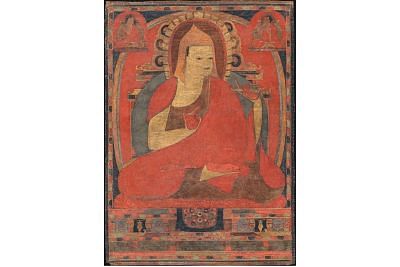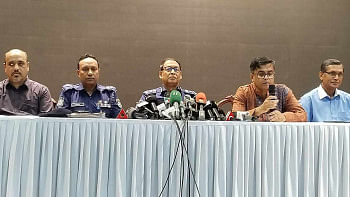1033rd Birth Anniversary of Saint Atisha Dipankara Srijnan

Photoi: wikipedia
As a child I often visited Kamalapur Bouddha Mahavihara with my father as we lived nearby. Kamalapur Bouddha Vihar became most venerable with the gift of ash relic of Atisha Dipankara Srijnan in 1978 by the government of China in honour of Atisha's birthplace as a token of friendship between China and Bangladesh.
Atisha was known all over the Buddhist world, particularly in Tibet, except in his own birthplace. For hundreds of years Atisha was known only in the limited context of Tantric Buddhism but not as a reformer of Buddhism.
As Buddhism became more complicated and divided, Atisha Dipankara appeared as a reformer and simplified Buddhism into a practice based on compassion. Atisha synthesised the Buddhist teaching of Sutra and Tantra in one book and offered the world a simple manual for obtaining Enlightenment.
After Unesco recognised Vajrajogini in Munshiganj as his birthplace and placed a Unesco World Heritage Site monogram in 2002, Atisha was finally rediscovered in his own motherland.
Atisha was born in 980 AD in the Royal family of Gouda in Vajrajogini village in Vikrampur, known at present as Munshiganj District. Atisha's village is stilled called Vajrajogini.
The story of Atisha is like Buddha's story. Both were born as princes and one left home to free humanity from sorrow and rebirth, while the other left home to spread the knowledge given by Buddha.
There were also other Buddhist scholars, like Siddah Caryias, born in Bangladesh but Atisha was considered the greatest Buddhist scholar and saint. Students and scholars from all over the world came to visit, study or teach in Mainamati, Paharpur, Jaggadal, Mahashan and other famous monasteries in Bangladesh. Atisha taught in many of these monasteries.
Atisha's earliest education began with the famous Pandit Jethari, under whom he studied five science subjects. Then he studied Hinayana and Mahayana forms of Buddhism under Pandit Rahul Gupta. He devoted himself to meditation at the famous Krishnagiri Mahashram near Bombay. At the age of nineteen he took his vows as a monk from Achariya Shila Rakshit at Odantapuri Vihara, who gave him the name Atisha Dipankara Srijanan.
After twelve years, at the age of thirty-one, Atisha finally became ordained as a Bhikku under Achariya Dharma Rakshit. He left home to study further under the great Pandit Chandrakirti in Subharna Dwip. After a dangerous sea voyage which took months he arrived in Java and Subharna Dwip where he studied for twelve years. He finally returned to Magadha via Singhal (Sri Lanka). King Mahipala was successful in imploring Atisha to accept the post of Mahacharya at the famous Vikramshila Mahavihara.
During the middle of the 11th century, Pandit Lama Yes Hod, the king of Tibet, wanted to free and reform Buddhism as practiced in Tibet. He sent several messengers with many gifts for Atisha to travel to Tibet and reform the religion, but Atisha refused. When the king died a sad death at the hands of an enemy, Atisha agreed to travel to Tibet to teach Buddhism. When the principal Ratnakara heard the news he said: “Without Atisha India will be in the darkness.â€
Atisha was granted leave on condition that he would return within three years. He was accompanied by many scholars and disciples, including Padmaprava, son of the king of Nepal. He arrived in the western part of Tibet at Holing Vihara where he began to preach Mahayana Buddhism, which was accepted spontaneously by the Tibetans. According to Tibetan Tanjore he wrote 175 books and translated many from Sanskrit to Tibetan. This was the reform and renaissance of Buddhism which the late king had dreamt of. After thirteen years of teaching, writing and spreading Buddhism he died in Tibet at Snye-thang Monastery.
Atisha arrived in Tibet in the 11th century, perhaps following the South East Silk Road through Brahmaputra valley which had existed in 450 BC at the time of spread of Buddhism. Many Chinese monks such as Hsuan, Tao-Sheng came to India using the Tibetan route in 650. Between 5th and 7th centuries, Yijing and Huen Tsang came to Bangladesh via the Brahmaputra valley.
It is believed that Bangladesh was well within one of the famous Silk Roads which touched South Asia. It was not only trade which attracted the traders but also Buddhism, which flourished here. The recent excavations point to a greater exchange and connectivity during the time when Buddhism played an important part in the region. A significant trade of both material and spiritual kind took place through the southern Silk Road.
Today, Bangladeshi and international archeologists are excavating and unveiling important cultural and historical evidence of Bangladesh being a route for passage of a very important product, Buddhism. Isolated urban centres, forts and monasteries more than a thousand years old needed patronisation, which may have come from powerful royal households or Silk Road traders.
In 1995, I visited Tibet to pay my respect to Atisha and visited the temple where the bodily remains of the greatest Bengali Siddha rests. How did he and other Buddhist scholars travel from the Ganga-Brahmaputra plains and how did they survive the harsh climate at such high altitude? They had to walk and trek all the way up there. That they lived in Tibet, wrote immortal classics, preached in Tibet seemed a deep mystery to me. I could hardly breathe, walk or talk because of lack of oxygen and high altitude conditions.
The temple, Snye-thang Monastery, where Atisha died in 1054 lies out side Lhasa by the Brahmaputra River, one of the mighty rivers that flow down Bangladesh into the Bay of Bengal, thus connecting China, India and Bangladesh. As I came from the land of Atisha the monks and chief of Tibetan Buddhists all accepted me with great affection. I stood in silence by the urn containing Atisha's ashes. Some of the ashes rest in Beijing and some were sent to Bangladesh by the Chinese government as a token of respect for Atisha's birth place. I planted a tree in the courtyard where Atisha used to sit and meditate. A smooth and cool stone slab where Atisha used to sit remains, as if waiting for the master to return. There were many old and faded but carefully wrapped tankas in an adjacent room where the monks were chanting constantly. These tankas are said to be from Atisha's time. On the top shelves many ancient manuscripts and prayers books are preserved.
On the other side of the narrow river stood a small hill on which a large mural painting of Atisha illumined the grey landscape. The rich mineral colours made the beautiful image of Atisha very fresh, and have survived a thousand years.
In my book, A Thousand Year Old Bengali Mystic Poetry (1992), I included three Carya poems by Atisha Srijanan Dipankara, photocopies of which I obtained from the National Library in Bhutan. There are memories and relics of Atisha in Bangladesh, India, Nepal, Bhutan and Tibet.
I revisited Atisha's birth place on February 8, 2013. A pavilion was built by the Chinese government in memory of Atisha in 2004. It was deserted. The Atisha Dipankara Library and Auditorium was under lock and key. I could not locate the original Unesco monogram.
In view of the current tension in Bangladesh, Buddhist heritage needs to be reappraised by the modern generation as the proud inheritor of a composite culture in which each religion played a significant role.
Atisha taught Karuna and Mahakaruna (compassion) to the world. Buddha's message of peace and coexistence of all beings was taught by him in a simple way.

 For all latest news, follow The Daily Star's Google News channel.
For all latest news, follow The Daily Star's Google News channel. 



Comments